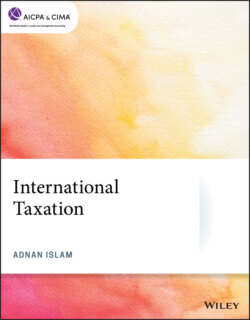Читать книгу International Taxation - Adnan Islam - Страница 68
Example 2-12
ОглавлениеA taxpayer whose functional currency is the dollar acquires a debt instrument denominated in Qs for Q5,000. The debt is not part of a Section 988 hedging transaction. The exchange rate at the time of the acquisition was Q1 = $.20. If the taxpayer sells the debt instrument for Q6,000 when the exchange rate is Q1 = $.24, of the $440 gain ([Q6,000 × $.24] − [Q5,000 × $.20]), $200 is a foreign currency gain ([$.24 − $.20] × Q5,000). If the taxpayer sells the debt instrument for Q6,000 when the exchange rate is Q1 = $.167, there would be no gain or loss on the Section 988 transaction ([Q6,000 × $.1667] − [Q5,000 × $.20]) and therefore no foreign currency gain or loss. If the exchange rate at the time of the sale was Q1 = $.19, there is a gain of $140 ([Q6,000 × $.19] − [Q5,000 × $.20]) but none of it is a foreign currency gain. If the exchange rate was Q1 = $.15, there is a loss of $100, all of which is a foreign currency loss.
A Section 988 transaction includes a disposition of nonfunctional currency and certain transactions if the amount the taxpayer is entitled to receive or pay because of the transaction is denominated in terms of a nonfunctional currency or is determined by reference to the value of one or more nonfunctional currencies. These Section 988 transactions include the following:
The taxpayer disposes of nonfunctional currency, which includes coin, currency, nonfunctional currency-denominated demand or time deposits, and similar instruments issued by a bank or other financial institution. These transactions are treated as Section 988 transactions for the purpose of establishing the taxpayer’s basis in the currency and determining exchange gains or losses.
The taxpayer acquires a debt instrument or becomes an obligor under a debt instrument.
The taxpayer accrues or otherwise considers any item of expense or gross income or receipts that is to be paid or received after the date on which it is so accrued or considered.
The taxpayer enters into or acquires any forward contract, futures contract, option, or similar financial instrument (which includes a notional principal contract). This provision covers a forward contract, futures contract, option, warrant, or similar property only if the underlying property to which the instrument ultimately relates is a nonfunctional currency or is a payable or receivable. For example, a forward contract to purchase wheat denominated in a nonfunctional currency is not covered, whereas a forward contract to purchase a nonfunctional currency is covered (Treasury Regulation1.988-1(a)(2)(iii)(A)). A notional principal contract means an interest rate swap, cap, floor, collar, or similar financial instrument that provides for the payment of amounts by one party to another at specific intervals measured by interest rates and notional principal amounts in exchange for specific consideration or a promise to pay similar amounts. It also includes a currency swap.
